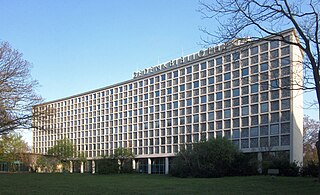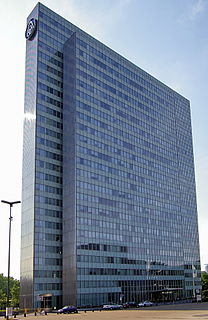Life
Schulte-Frohlinde was trained by Paul Bonatz and was part of his Stuttgart school. On the recommendation of Albert Speer, in 1934 Schulte-Frohlinde went to work under Robert Ley's German Labour Front (popularly known as the DAF, an abbreviation for Deutsche Arbeitsfront). The architect was named as the architect-director of the Schönheit der Arbeit (SdA, "Beauty of Work"), a DAF suborganization tasked to make workplaces more enticing to workers.
Schulte-Frohlinde developed and ran his own building department within the SdA beginning in 1936, and worked directly for the National Socialist government until its collapse in 1945, constructing DAF administration buildings, training schools, and helping to plan the Kraft durch Freude seaside resort called Prora on the German island of Rügen. The architect was openly anti-Semitic and unmistakably aligned with the goals and methods of the Nazis.
After 1945 Schulte-Frohlinde retreated to his hometown Bremen. In 1952 he became involved in the reconstruction of Stuttgart and withstood criticism from Bernhard Pfau, among others, for his political history and National Socialist aesthetics.
On the role of architecture in the reconquered east by the Nazis Schulte-Frohline wrote:
- "We are fighting for Germany, for the maintenance and recovery of the soul of our people, which is mirrored most visibly in our craft and architectural culture (Gr Kultur)."

The German Labour Front was the labour organisation under the Nazi Party which replaced the various independent trade unions in Germany during Adolf Hitler's rise to power.

Egon Eiermann was one of Germany's most prominent architects in the second half of the 20th century. He was also a furniture designer. Since 1947, he was Professor for architecture at the Technical University of Karlsruhe.

Erich Mendelsohn was a German architect, known for his expressionist architecture in the 1920s, as well as for developing a dynamic functionalism in his projects for department stores and cinemas. Mendelsohn was a pioneer of the Art Deco and Streamline Moderne architecture, notably with his 1921 Mossehaus design.

Max Littmann was a German architect.

Bernhard Hans Henry Scharoun was a German architect best known for designing the Berliner Philharmonie and the Schminke House in Löbau, Saxony. He was an important exponent of organic and expressionist architecture.

Fritz Bornemann was a German architect.

The Militant League for German Culture, was a nationalistic anti-Semitic political society during the Weimar Republic and the Nazi era. It was founded in 1928 as the Nationalsozialistische Gesellschaft für deutsche Kultur by Nazi ideologue Alfred Rosenberg and remained under his leadership until it was reorganized and renamed to the National Socialist Culture Community in 1934.

The Dreischeibenhaus is a 95-metre office building in August-Thyssen-Straße in the Hofgarten district of the Düsseldorf city centre. It was also known as the Thyssenhaus or Thyssen-Hochhaus owing to its former use as the headquarters of the Thyssen and ThyssenKrupp groups. It is among the most significant examples of post-war modernist International style and a symbol of the so-called Wirtschaftswunder, or 'economic miracle' of post-war Germany, and contrasts with the neighbouring Düsseldorfer Schauspielhaus on Gustaf-Gründgens-Platz. Dreischeibenhaus, The "Three Plates Building", was one of the first skyscrapers to be completed in Germany after WW2.

The German Football Museum aka DFB-Museum is the national museum for German football in Dortmund, Germany. It opened on 23 October 2015.

Edmund Collein was an East German architect and urban planner. He is also known for his photography while studying at the Bauhaus art school.

Nazi architecture is the architecture promoted by Adolf Hitler and the Nazi regime from 1933 until its fall in 1945, connected with urban planning in Nazi Germany. It is characterized by three forms: a stripped neoclassicism, typified by the designs of Albert Speer; a vernacular style that drew inspiration from traditional rural architecture, especially alpine; and a utilitarian style followed for major infrastructure projects and industrial or military complexes. Nazi ideology took a pluralist attitude to architecture; however, Adolf Hitler himself believed that form follows function and wrote against "stupid imitations of the past".
Otto Voelckers was a German architect and technical author.
Josef Kaiser was an East German urban architect associated, in particular, with a number of the country's more high-profile building projects during the 1950s and 1960s. In 1946, following serious illness, he embarked on a career as an operatic tenor: five years later he returned to architecture.
Ludwig Becker was a German politician, member of the Communist Party of Germany, and trades unionist who participated in illegal political opposition during the Nazi years.
Paul Francke was a German Renaissance architect, most notable as director of works for the Duchy of Brunswick-Lüneburg from 1564 until his death in 1615. His works include the Juleum Novum in Helmstedt, the Marienkirche in Wolfenbüttel and the Burganlage in Erichsburg.

Ludwig Julius Eisenberg was an Austrian writer and encyclopedist. He wrote a lexicon of stage artists, among other publications.
Wolfgang Boetticher was a German musicologist and longtime lecturer at the University of Göttingen.

Helmut Hentrich was a German architect who became particularly known for his striking high-rise buildings in the 1960s and 1970s. The architectural firm he founded, Hentrich, Petschnigg und Partner (HPP), still exists under the name HPP Architekten.

Volker Staab is a German architect.
Rudolf Hillebrecht was a German architect and city planner. In 1948, against an impressive list of rival candidates, he succeeded in obtaining appointment as city planning officer for his home city of Hannover, with a mandate to rebuild a city that had suffered massive bomb damage between 1942 and 1945. He approached his task with evangelical zeal. His ideas for post-war Hanover aligned with the prevailing spirit of the "Wirtschaftswunder" years, and by 1959 it was possible to boast that Hannover was the only city in West Germany with its own network of city motorways, while Hillebrecht had probably become the only man alive in Hannover with an international reputation. Urban developments during the next twenty years repeatedly demonstrated the extent of Hillebrand's influence across and beyond western Europe. His redevelopment of Hannover was nevertheless not uncontroversial even at the time. A large number of historical buildings that had somehow survived Anglo-American bombing were now destroyed out of deference to a larger plan: some of the Hilebrecht plans involving wholesale destruction and replacement of entire districts of the city were indeed never implemented. Hillebrecht himself later conceded that the destruction, during the early 1960s, of Hannover's striking neo-Renaissance "Flusswasserkunst" had been a mistake.
This page is based on this
Wikipedia article Text is available under the
CC BY-SA 4.0 license; additional terms may apply.
Images, videos and audio are available under their respective licenses.












